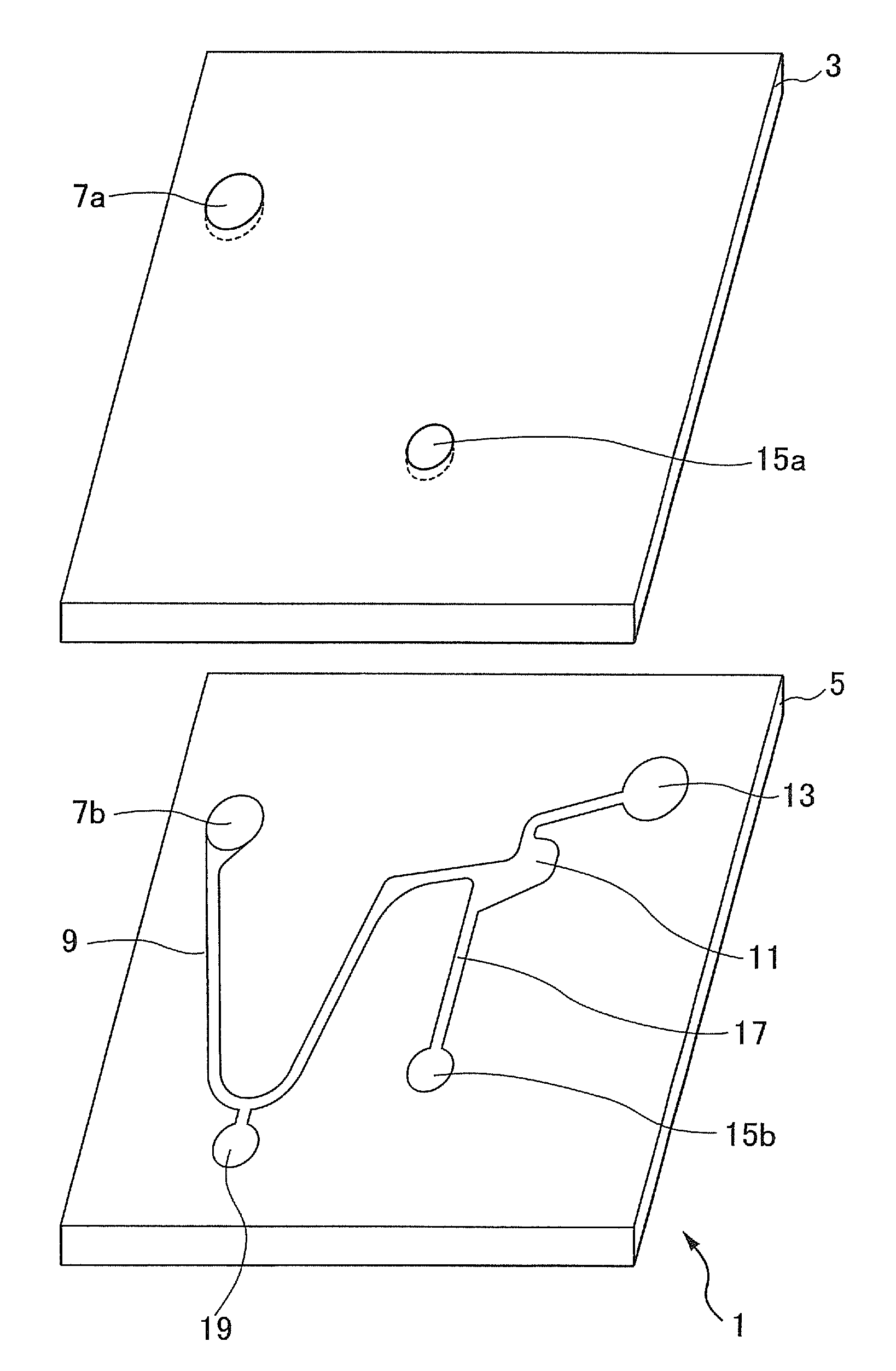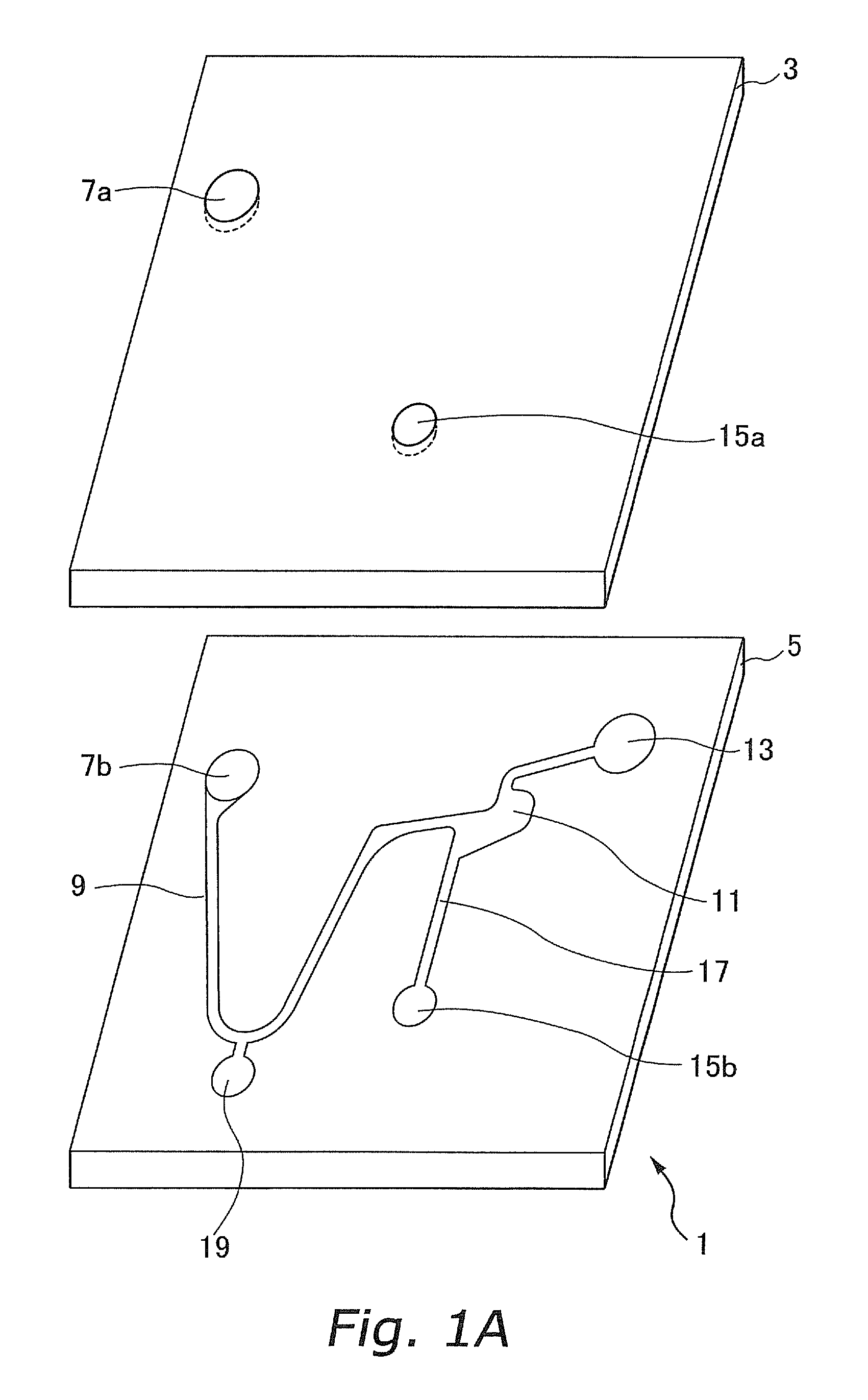Chip using method and test chip
a technology of test chips and methods, applied in the field of test chips using methods, can solve the problems of complex processing, inability to provide efficient extraction of target components from samples, and insufficient means for plasma measurement after separation, so as to simplify the structure of the entire apparatus, simplify the process, and accurately measure the
- Summary
- Abstract
- Description
- Claims
- Application Information
AI Technical Summary
Benefits of technology
Problems solved by technology
Method used
Image
Examples
first embodiment
[0151]FIGS. 8A and 8B are perspective views of a test chip according to the first embodiment of the present invention.
(1) Overall Configuration of the Test Chip
[0152]A test chip 100 of the first embodiment comprises an inlet 105 for a sample containing a target component, a centrifugal separation tube 201, a holding section (203a, 203b) 203, a first measuring section (205a, 205b) 205, a waste fluid reservoir (207a, 207b) 207, a removing tube 209, a primary mixing section 217, a reagent reservoir (219a, 219b) 219 for storing a reagent, a secondary mixing section 220 comprising a mixer section 220a, a photodetection path 230, a light inlet 233, a light outlet 235, an outlet 240, and a regulation tube (241a, 241b) 241. As shown in FIGS. 9A and 9B, this test chip 1 separates and measures a target component, and mixes the target component and a reagent by rotation around the first axis of rotation 310 and the second axis of rotation 311 described below.
[0153]An inlet 105 incorporates a s...
second embodiment
[0206]FIG. 27 is a perspective view of a test chip according to a second embodiment of the present invention, FIG. 28 is an explanatory diagram describing the principal portion of FIG. 27, FIG. 29 is a perspective view of another test chip according to the second embodiment, and FIG. 30 is an explanatory diagram describing the principal portion of FIG. 29. The second embodiment has the same configuration as that of the first embodiment except for being able to measure an introduced reagent using a reagent measuring section 670, a discarded reagent reservoir 675, a reagent removing tube 677, and a reagent introductory section 679. Identical reference notations and numerals represent identical structural elements.
[0207]A test chip 400 of FIG. 27 comprises an inlet 105 for a sample comprising a target component, a centrifugal separation tube 201, a first holding section (203a, 203b) 203, a first measuring section (205a, 205b) 205, a waste fluid reservoir (207a, 207b) 207, a removing tu...
third embodiment
[0212]FIG. 31 is a perspective view of a test chip according to a third embodiment of the present invention, FIG. 32 is a plan view of FIG. 31, and FIG. 33 shows a detecting device having the test chip of FIG. 31 placed thereon. The third embodiment has the same configuration as that of the first embodiment except that a plurality of determining sections (200a, 200b, 200c) 200 comprising a measuring section, a mixing section, etc. are provided so that a plurality of tests may be performed, and that the configuration in the vicinity of the substrate of the light inlet 233 and the light outlet 235 differs from that of the first embodiment. Identical notations and numerals represent identical structural elements.
[0213]A test chip 100 of the third embodiment comprises an inlet 105 of a sample comprising a target component, a centrifugal separation tube 201, a first holding section 203, a plurality of determining sections (200a, 200b, 200c) 200, a waste fluid reservoir 207, and a regulat...
PUM
| Property | Measurement | Unit |
|---|---|---|
| angle | aaaaa | aaaaa |
| angle of contact | aaaaa | aaaaa |
| depths | aaaaa | aaaaa |
Abstract
Description
Claims
Application Information
 Login to View More
Login to View More - R&D
- Intellectual Property
- Life Sciences
- Materials
- Tech Scout
- Unparalleled Data Quality
- Higher Quality Content
- 60% Fewer Hallucinations
Browse by: Latest US Patents, China's latest patents, Technical Efficacy Thesaurus, Application Domain, Technology Topic, Popular Technical Reports.
© 2025 PatSnap. All rights reserved.Legal|Privacy policy|Modern Slavery Act Transparency Statement|Sitemap|About US| Contact US: help@patsnap.com



